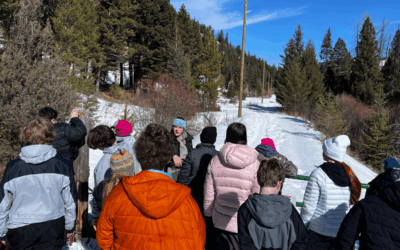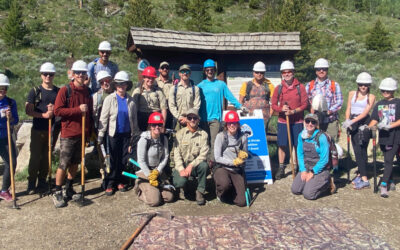The Continental Divide Trail (CDT) unites us. From Gateway Community residents to thru-travelers, and everyone in between, our diverse community is connected by our mission to protect the CDT. We are showcasing stories of the people and places that make up our community with our series, Voices of the CDT. Each month, look out for new stories that highlight these diverse experiences, histories, and faces, against the backdrop of the awe-inspiring Continental Divide.
INTERESTED IN SHARING YOUR CONNECTION TO THESE LANDSCAPES? SEND US YOUR STORY AT [email protected] FOR A CHANCE TO BE FEATURED!
Native American Horticulturist and Hiker

Photo courtesy of Nevaeh
This summer I worked with the American Indian College Fund and the Continental Divide Trail Coalition for an internship researching Indigenous flora on the CDT. As an Indigenous person, I have a spiritual and cultural connection to the natural world. I was taught that all material and spiritual things have a spirit and should be respected as equals. When being outdoors and working with the earth, I feel closer to my culture and family.
Growing up, my family and I would travel the Michigan Powwow Trail each summer. We went to a different location in Michigan each weekend, setting up the family restaurant, Rose’s Food Stand. Rose’s has been a part of my family for over 80 years and is the oldest documented native food stand in Michigan. While my family fed everyone traditional foods, I spent my time dancing in the arena, feeling the earth under my moccasins and singing in my ears.
Now, I’m entering my third year at Michigan State University studying Horticulture Science with a minor in American Indian and Indigenous Studies. I am a proud member of the Sault Ste. Marie band of Chippewa Indians located in the upper peninsula of Michigan. Outside of class, I still go to powwows and enjoy making traditional foods for my friends and family. While working at the CDTC, I also worked at WJ Beal Gardens, a botanical garden on Michigan State’s Campus.
During my work with the CDT, I was able to identify several native plants on the trails such as big sagebrush (Artemisia tridentata) and lamb’s quarters (Chenopodium album). I focused my project on plants that had a cultural, medicinal, or spiritual significance to Indigenous people along the Continental Divide Trail. For this, I drove 17 hours from Michigan to Colorado to spend time on the trail.
My most memorable moment on the CDT was during my time near Interlaken trail. Interlaken trail is a 4.6 mile out and back trail on the coast of Twin Lakes. Twin Lakes are two glacial lakes located near Leadville, CO. During the hike, my friend Eliza and I decided to go sit by the lake. We climbed over the small boulders and rocks to reach the water and just as we got close to the shore, I slipped on a wet rock and fell into the lake. Rolling with the punches, we decided it would be a great time to go swimming since I was already soaked head to toe. We laid out in the sun, waiting for our clothes to dry enough to walk back to the trailhead. It ended up being my favorite part of the day.
Nevaeh Marshall is a member of the Sault Ste. Marie Band of Chippewa Native Americans in the Upper Peninsula of Michigan, and spent time with the Pokagon Band of Potawatomi growing up in South Bend, Indiana. She is a third year undergraduate student at Michigan State University studying Horticulture Science with a minor in Indigenous Studies, and is currently working with the American Indian College Fund and the Continental Divide Trail Coalition as a Trail Experience Intern, focusing on Indigenous flora along the CDT. After finishing her bachelor’s degree, she plans on working in Indigenous Horticulture, conservation, and food sovereignty.



